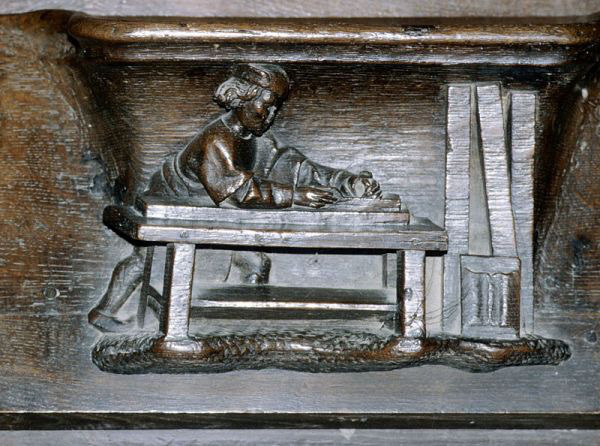
16th c., Church of St.-Germain, Presles, France
In this last post on misericords there are carpenters, benches, axe men, one holdfast, one really old misericord, a measured drawing (!) and rabbets rabbits.
One of the fascinating things about misericords is how the craftsman chose to position his subject on these tricky pie-shaped hunks of wood. In the example at the top the viewer is looking into a small shop created under the bracket. By placing the carpenter behind the bench the details of the bench can clearly be seen.

Late 16th c., Church of St.-Andre, Besse-et-Saint Anastaise, France.
This older misericord with more wear and tear was done by a lesser-skilled hand. Although the carver has given dimension to the bench it is awkwardly angled outward and the carpenter’s head has been twisted almost 180 degrees (ouch).

Late 16th c., Church of St.-Andre, Besse -et-Saint Anastaise, France.
From the same church and by the same carver here’s another odd angle but a much happier carpenter.

Early 16th c., Abbey Church, Noyers, France.
The same idea as the previous two misericords but with a loss of perspective and dimension for the bench. Despite the varying levels of skill in the carvers there was still an effort to show details of the bench, to show the carpenter actually working, and however awkward, to show their faces to the viewer.

16th c., Chirch of St.-Germain, Ormes, France.
Seen from two slightly different angles the carver attempted a bird’s- eye view.

16th c., Church of St.-Germain, Soisy-et-sous-Montmorency, France. Restoration was done in the 1980s.
Although portions are missing the carver provided a dimensional bench and good body position with wonderful detail. The vanishing-point perspective of the floor adds nice depth to the scene.

Bas-relief on a choir stall 1449-1465, restoration (or recreation) 1862-1872. North side of Cathedral of Saint-Claude, Jura, France.
The bas-relief in the Cathedral of Saint-Claude is the only carving showing a holdfast and with a 15th century date it was important to get more information on its history and the original artist. Without the holdfast this example would have been included in the blog post depicting misericord carvers.
Jehan de Vitry of Geneva worked on the choir stalls of Saint-Claude for 15 years, finishing them in 1465. The choir stalls were massive with two sections, each 15 meters long, and backed by a series of tall panels carved in bas-relief. As churches were expanded, or as happened during the Reformation cleared out, a common fate for choir stalls was rearrangement, relocation to another church, or sold for profit. In 1768 the choir stalls of Saint-Claude were cut down, rearranged and covered in ochre paint.
After 400 years heavy restoration was needed, especially for the misericords. From 1869-1875 restoration was done and another rearrangement. The choir stalls were put on the north and south sides of the choir and nave. This rearrangement resulted in some “excess” pieces that were sold off to collectors. Some of those pieces now reside in the Louvre and the Victoria & Albert Museum.

Enlargement of the Saint-Claude carpenter with holdfast.
One of the sculptors involved in the 19th century restoration was Alexis Girardet and although the records are not clear it is thought he carved the carpenter with the bench and holdfast. I could not confirm if he reproduced a damaged carving or if this is his own design. I suspect it is his own design because if you look closely at the front left edge of the workbench you will see the initials A. G. To my eye there are some style differences compared to the other bas-reliefs on the inside “walls” of the stalls and no other works had the carver’s initials. So, no 15th century holdfast. Bummer.
But on a brighter note we know when the trees were cut down for the original 15th century construction of the choir stalls. A dendrology study done in the 1980s revealed the trees were cut down in the autumn of 1445 or the winter of 1446.
The troubles for the choir stalls at Saint-Claude continued. On September 26, 1983 there was a fire and the 22 choir stalls on the south side were destroyed. As Saint-Claude is considered a French national monument, photographs on record before the fire were used by an atelier commissioned to recreate the south-side choir stalls.

You may have seen this drawing used in presentations on carpenter’s guilds or with an description from the 19th century: “Carpenter’s apprentice working on a trial piece.” The original is a 15th century misericord from Rouen, France.

1457-1470, Notre-Dame Cathedral, Rouen, France.
There are photos of this misericord with a conservation-style repair to the bracket (I don’t know which is the more recent photo). Two other Rouen misericords are carvers and they have similar body positions which I am now calling “Downward Carpenter.”
One of the oldest, if not the oldest, misericords in Great Britain is in St. Mary the Virgin Church in Hemingbrough. It is dated around 1200, the Early English period.

Top: Last and oldest misericord, dated 1200. Bottom left: measured drawing of choir stall. Bottom right: last remaining choir stalls (back row). St. Mary the Virgin Church, Hemingbrough, England.
The open-work of the Hemingbrough misericord is quite different from most misericords. It is easy to see how this early example would be more prone to damage and given the age, more susceptible to theft.
How much is a “used” misericord worth these days?

Misericord from an auction site.
This misericord is dated around 1450 and is of either English or Flemish origin. Although it is very worn and damaged the auction estimate was $2000 to $4000 (USD) and it sold for close to $8500.
In the gallery in one more (partial) workbench, the axe men and a few other bits.
–Suzanne Ellison









Filed under: Carving
![]()
SOURCE: Lost Art Press – Read entire story here.



